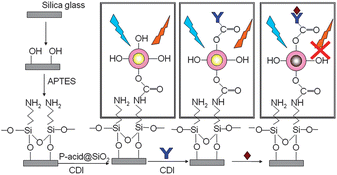Fluorescence immunosensor based on p-acid-encapsulated silica nanoparticles for tumor marker detection
Abstract
A novel, simple and highly sensitive amplified fluorescence label-free immunosensor by using p-acid-encapsulated silica nanomaterials has been developed for the first time. 4,4′-(2,5-Dimethoxy-1,4-phenylene)bis(ethyne-2,1-diyl)dibenzoic acid (p-acid) and p-acid-encapsulated silica were prepared, and characterized by Fourier transform infrared spectroscopy, nuclear magnetic resonance, ultraviolet visible spectroscopy (UV-vis) and fluorescence spectroscopy. In layer-by-layer self-assembling processes using (3-aminopropyl)triethoxysilane, p-acid@SiO2 was assembled on the glass substrate. Antibody was immobilized on the surface of p-acid@SiO2 with N,N′-carbonyldiimidazole. The functional nanomaterials present good analytical properties with a calibration range of 0.1–100 ng mL−1, and allow the detection of carcinoembryonic antigen (CEA) at a concentration as low as 0.04 ng mL−1. What is important is that the as-synthesized p-acid@SiO2 nanomaterials could be further extended for the detection of other biomarkers or biocompounds.


 Please wait while we load your content...
Please wait while we load your content...